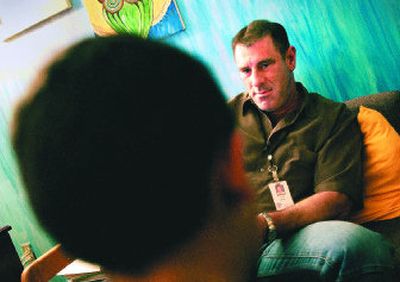The dark signs of abuse

Paul Haupt settles his 6-foot-2-inch frame on a couch in the cramped counselor’s office at Spokane’s Stevens Elementary School. The state Children’s Administration social worker already has reviewed the paper files on the two children, ages 9 and 6, that he’s here to see.
Now, he’s preparing for the hard part: The personal interviews that will help reveal whether the youngsters are victims of child abuse or neglect.
Haupt, 45, knows how scary it can seem. So, when the small boy in the blue sweat shirt and white sneakers slides reluctantly onto a chair, Haupt softens his posture and his voice, leaning far forward to say: “Hey, Buddy. How you doing?”
For the next 45 minutes, the veteran social worker will ask the child, and, later, his little sister, about every aspect of their domestic life. Do you have food at your house? What did you have this morning for breakfast? Does your mama leave you home alone a lot? What happens when you are punished? Where would you go if you had trouble?
Haupt, who’s been doing this kind of work for two decades in several states, is looking for answers that indicate serious problems and, often, he finds them.
“I think people have no idea,” he said. “The family I grew up in, there was no domestic violence, no yelling, no screaming. They think that’s the way the world is.”
Fortunately, the children he’s interviewing this March afternoon are fine, for now. An allegation that they were left alone too long turned out to be a misunderstanding with a neighbor. A follow-up home visit revealed an apartment filled with clutter and a mother overwhelmed by parenthood and poverty, but amenable to counseling and support.
But even a cursory review of notes from state workers shows that that’s not always so. Following are state definitions of the most common kinds of abuse, with examples from Spokane County social workers’ reports in 2006.
Abuse or neglect
In Washington, abuse or neglect is defined as any sexual abuse, sexual exploitation or other injury that causes harm to the child’s “health, welfare or safety.”
That includes unreasonable use of force to correct or restrain children, which is defined to include: throwing, kicking, burning or cutting a child; shaking a child under age 3; interfering with a child’s breathing; threatening a child with a deadly weapon; doing any other act likely to cause or “which does cause bodily harm greater than transient pain or minor temporary marks.”
02/15/06: “Baseline level of risk: 4 – moderately high risk. Referral was received from law enforcement. … C and C have two children in common; D, age 8, and M, age 2. … D returned to the mother’s home following a weekend visit with his father. D told his mother that his father held a knife to his throat and threatened to kill him. The mother immediately contacted law enforcement. … The responding deputy observed a small scab on D’s neck.”
12/04/06: “Baseline report: 4 - moderately high risk. … Last winter A was partying and got into a top bunk bed with two intoxicated men. T was left on the floor unsupervised. T was crying and scooted himself into a heater and got 3rd degree burns on his head. The mother did not get up to take care of him.”
Negligent treatment or maltreatment
Behavior that includes action or lack of action or a pattern of conduct that shows a serious disregard for consequences that constitute a “clear and present danger to the child’s health, welfare or safety.” Starting this year, evidence of a parent’s substance abuse is “given great weight” as a contributing factor to negligence.
07/11/06: “Baseline level of risk: 5 - high risk. The police called the department to the family home. … The worker was walked through the home. The entire home had approximately a foot and a half of garbage and clothes strewn about and no visible clean surfaces. The bathroom was dirty with garbage piled from the floor to the wall and the bathing area appeared unused with garbage around and in it. The children’s bedroom floor was not visible and there were mice in their dresser drawers. Their mattresses were dirty with mice nests inside areas that had holes that appeared to be chewed up. Upstairs there was a long attic with a table in the middle of it. On the table was a computer and next to the computer the officer found small bags with methamphetamine residue. On the other side of the computer was an open pornographic magazine. There was garbage and boxes all over the floor with large knives sticking out of several of them. A (a child) reported to the officers that he played up in the attic sometimes.”